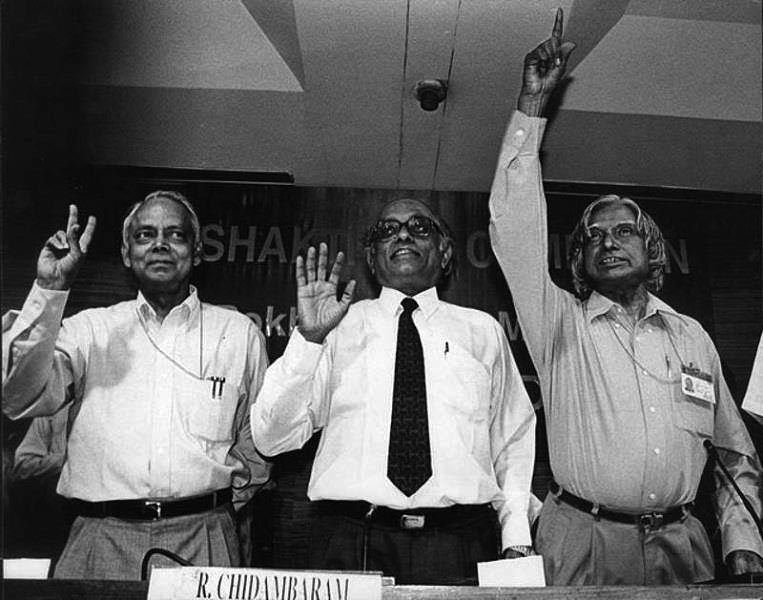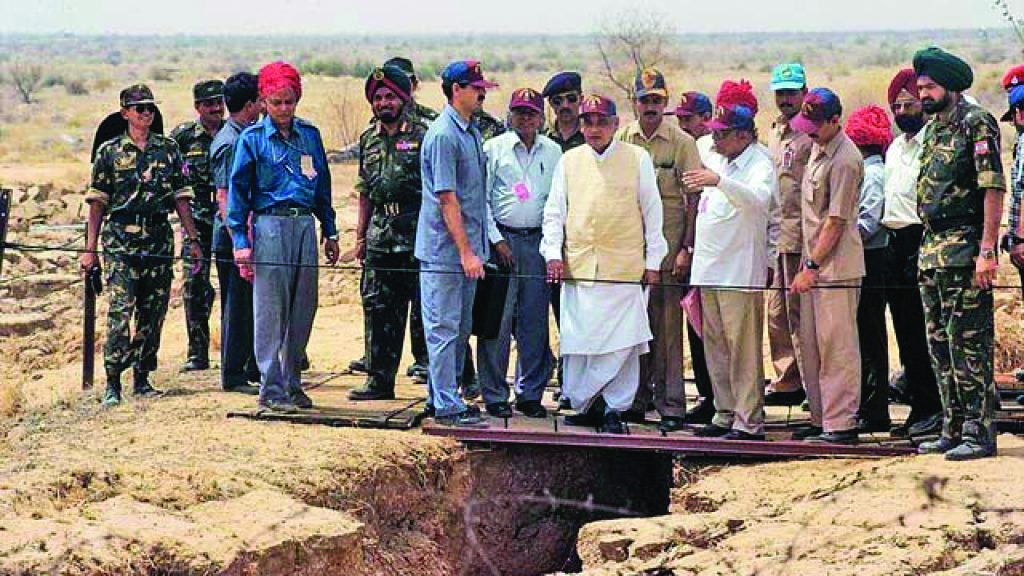Image Courtesy: Wikimedia Commons
OBITUARY/ Dr RAJAGOPALA CHIDAMBARAM (1936-2025)
Dr Rajagopala Chidambaram, a luminary in the field of Indian nuclear science, passed away on 4 January 2025, at the age of 88. He was a key architect of India’s nuclear programme, instrumental in advancing the nation’s scientific and strategic capabilities. His unparalleled contributions to the development of nuclear energy and his visionary leadership in science and technology have left an indelible mark on the country.
Born on 11 November 1936, in Chennai, Dr Chidambaram’s academic foundation was rooted in physics. He obtained his BSc (Hons) and MSc in Physics from Madras University, followed by a PhD in nuclear magnetic resonance from the Indian Institute of Science (IISc) in 1962. His academic brilliance and deep interest in science were evident during his early years. Over his illustrious career, Dr Chidambaram made significant contributions to condensed matter physics and material science, earning him numerous accolades, including a DSc from IISc and honorary doctorates from prestigious institutions worldwide.
Dr Chidambaram’s personal life was marked by resilience and compassion. An episode from his childhood during the partition of India demonstrated his indomitable spirit and the kindness of strangers. Separated from his family amidst communal riots, he was rescued and sheltered by a Muslim family, who eventually reunited him with his loved ones. This formative experience underscored his belief in harmony and mutual respect, values he carried throughout his life.

Images Courtesy: Internet
AT THE HEAD OF INDIA’S NUCLEAR FORAYS
In 1962, Dr Chidambaram joined the Atomic Energy Establishment, Trombay (AEET), later renamed the Bhabha Atomic Research Centre (BARC) in honour of Dr Homi Bhabha. Dr. Chidambaram rose to prominence within the scientific community due to his pioneering work in nuclear physics and high-pressure materials science. He served as the Director of BARC from 1990 to 1993, laying the groundwork for several significant advancements in nuclear technology. Under his leadership, India conducted its first nuclear test, ‘Smiling Buddha’, in 1974, and the subsequent ‘Operation Shakti’ tests in 1998, cementing India’s position as a nuclear power on the global stage.
As Chairman of the Atomic Energy Commission (1993-2000) and Secretary to the Government of India, Department of Atomic Energy, Dr Chidambaram’s role was pivotal in strengthening India’s nuclear and strategic technology. He led the Department of Atomic Energy team in designing and executing the nuclear devices for both Pokhran-I and Pokhran-II tests, ensuring that India’s nuclear deterrence was robust and credible. His unwavering commitment to India’s self-reliance in strategic technologies made him a national icon.
Beyond his contributions to nuclear science, Dr Chidambaram’s tenure as Principal Scientific Adviser (PSA) to the Government of India (2001–2018) was marked by his visionary initiatives to integrate science and technology into the country’s developmental framework. As PSA, Chidambaram also chaired the Scientific Advisory Committee to the Cabinet (SAC-C). He spearheaded the establishment of the National Knowledge Network (NKN), which provided high-speed connectivity among research and educational institutions. This initiative became the backbone for research access and collaboration across India, fostering innovation and excellence in science and education.
Dr Chidambaram was also instrumental in launching the Rural Technology Action Groups (RuTAG) to address the technological needs of rural areas. These groups, established at leading engineering institutions, have been vital in enhancing the quality of life in rural communities through innovative and sustainable solutions. His leadership in inter-ministerial collaborations resulted in the Core Advisory Group for R&D in the Automotive Sector (CAR), promoting academia-industry interaction and driving technological advancements in the automotive sector. His efforts to create inter-institutional collaboration platforms have impacted India’s research and development landscape.

Images Courtesy: Internet
A champion of clean energy, Dr Chidambaram initiated and oversaw the Advanced Ultra Supercritical (AUSC) technology project for coal-based thermal power generation. This project, conceptualised during his tenure as Principal Scientific Adviser, aimed to enhance plant efficiency and reduce carbon emissions. By integrating the AUSC project into India’s National Action Plan for Climate Change, he underscored his commitment to sustainable development and environmental conservation.
Dr Chidambaram’s collaborative leadership extended to international platforms. He served as Chairman of the Board of Governors of the International Atomic Energy Agency (IAEA) and was a member of its Commission of Eminent Persons. His guidance and expertise were instrumental in shaping the IAEA’s vision for 2020 and beyond. His efforts helped enhance India’s global standing in nuclear science and technology.
Dr Chidambaram was a staunch advocate for empowering India’s scientific institutions throughout his career. He played a key role in nurturing organisations like the Tata Institute of Fundamental Research (TIFR) and the Indian Institute of Science, ensuring their growth as bastions of quality research and innovation. As Chancellor of the University of Hyderabad and Chairman of the Board of Governors of IIT Madras, he inspired countless young scientists and engineers to pursue excellence in their respective fields.
NURTURING MEDICAL TECHNOLOGY
In addition to his scientific achievements, Dr Chidambaram’s leadership in the medical technology sector was groundbreaking. He was instrumental in establishing the Dr Kalam Institute of Health Technology at AMTZ (Andhra Pradesh MedTech Zone Ltd), a public enterprise MedTech cluster aimed at promoting medical device manufacturing in India. This initiative significantly enhanced access to medical technology products globally and highlighted his commitment to improving public health through innovation.
Dr Chidambaram’s contributions were recognised with numerous awards and honours. He received the Padma Shri in 1975 and the Padma Vibhushan in 1999, among other prestigious accolades. His dedication to science and technology earned him fellowships in eminent Indian and international science academies. He was also a member of the Honorary Advisory Board of the international journal, Atom for Peace. He served on several high-level committees, reflecting his global influence in the scientific community.

Image Courtesy: Wikimedia Commons
An accomplished researcher, Dr Chidambaram authored over 200 research publications in peer-reviewed journals, focusing on high-pressure physics, condensed matter physics, and strategic technologies. His work on diamond anvil cells, gas guns for projectile launching, and theoretical research on the equation of state and phase stability of materials showcased his depth of knowledge and innovation.
Dr Chidambaram’s legacy is defined by his scientific achievements and his role as a mentor and leader. He was known for his ability to inspire and guide young scientists, fostering a culture of collaboration and creativity. His affable nature and commitment to nurturing talent made him a beloved figure within the scientific community.
ENHANCING EFFICIENCY OF THERMAL POWER GENERATION
Dr Chidambaram was key in initiating and overseeing the Advanced Ultra Supercritical (AUSC) technology project for coal-based thermal power generation in India. His involvement in this project was primarily during his tenure as the Principal Scientific Adviser to the Government of India from 2001 to 2018. The AUSC technology aims to increase plant efficiency to 46% compared to 38% in subcritical and 41-42% in supercritical plants. This is an important effort to reduce carbon footprint and move away from the current inefficient cal technologies (Calcium Looping technologies). It is expected to reduce coal consumption and CO2 emissions by about 11% compared to supercritical plants. The project involves developing an 800 MW AUSC Technology Demonstration Plant. He led the formation of a consortium of key organisations to work on the AUSC project, including IGCAR (Indira Gandhi Centre for Atomic Research), BHEL (Bharat Heavy Electricals Limited), and NTPC (National Thermal Power Corporation). Dr Chidambaram emphasised that the AUSC project was being developed in a mission mode, highlighting its importance and urgency. He integrated the AUSC project into the National Action Plan for Climate Change as the ninth mission, focusing on producing power based on clean energy. The projects initiated under his guidance continue to shape the nation’s scientific and technological trajectory.
Dr Chidambaram’s passing marks the end of an era for Indian science and technology. His legacy is a testament to the transformative power of visionary leadership, scientific innovation, and unwavering dedication to national progress. His life and work will inspire future generations to pursue excellence and contribute to the betterment of society.
As we reflect on Dr Rajagopala Chidambaram’s remarkable journey, we are reminded of the profound impact one individual can have on a nation’s destiny. His unwavering commitment to advancing India’s scientific and strategic capabilities has left an indelible mark on the country’s scientific prowess. He will be remembered not only as a towering figure in Indian science but also as a mentor, visionary, and advocate for integrating science and technology into the fabric of society. The void left by his departure is immense, but his legacy will continue to inspire and guide India’s scientific community for generations to come.
*Dr Navneet Kumar Gupta is a New Delhi-based freelance science communicator, while Dr Biju Dharmapalan is the Dean-Academic Affairs, Garden City University, Bangalore, & Adjunct faculty, National Institute of Advanced Studies, Bangalore.










